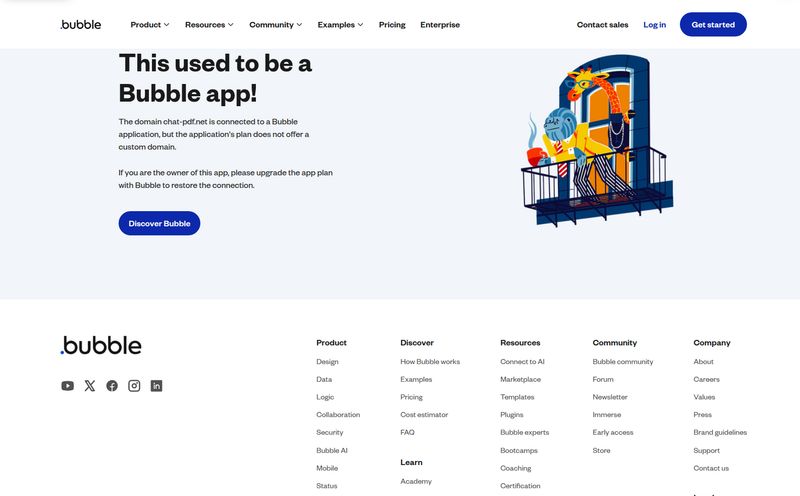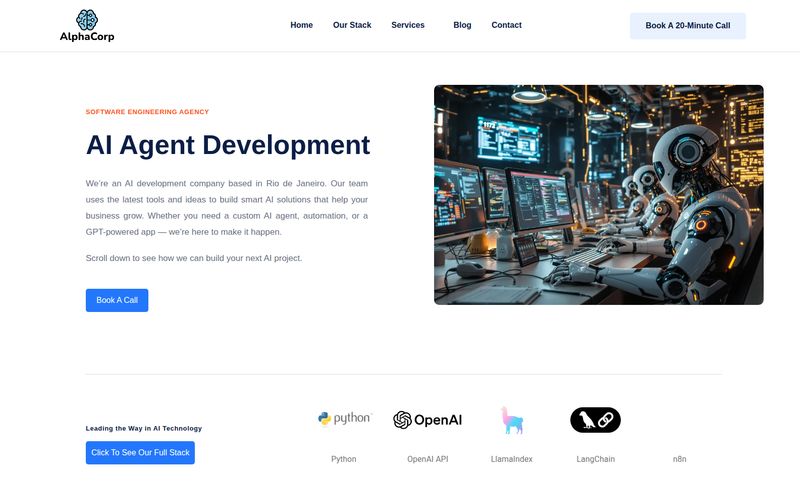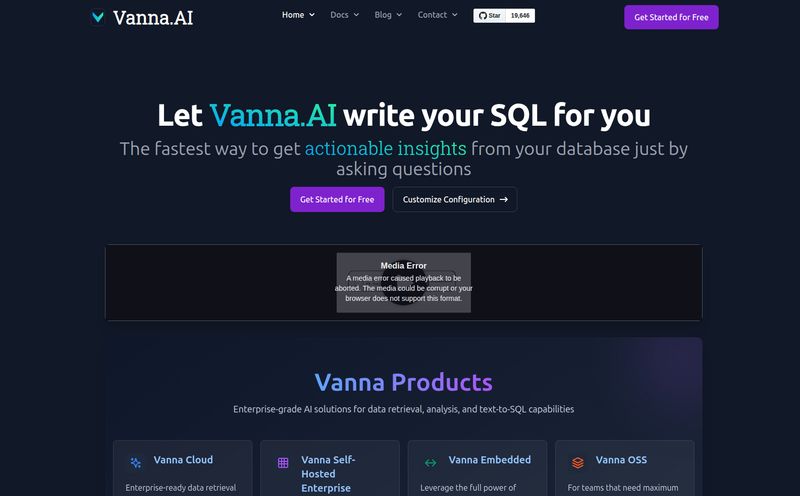If you're an accountant, bookkeeper, or even a small business owner who bravely wades into their own finances, you know the specific kind of dread that comes with a stack of PDF bank statements. It's a special kind of purgatory. Your eyes glaze over. The numbers start to swim. You promise yourself you'll just do one more page, but three hours later, you're lost in a sea of debits and credits, wondering if a career in artisanal cheese making might have been a better choice.
I've been there. As someone who has managed CPC campaigns and tracked marketing ROI down to the last penny, I've had my fair share of wrestling with financial documents. It’s tedious, it’s prone to error, and frankly, it’s a colossal waste of brainpower. So, when I stumbled upon a tool called Bank Statement Convert, my professional curiosity was definitely piqued. It claims to use AI to do the whole conversion from PDF to Excel in a click. A bold claim. But is it any good?

Visit Bank Statement Convert
So What is Bank Statement Convert Anyway?
At its core, Bank Statement Convert is a specialized tool designed for one job: turning those stubbornly static PDF bank statements into beautiful, usable Excel (or CSV) spreadsheets. Simple, right? But the secret sauce here is the engine it's running on—something called Llama 3 AI. This isn't just a basic text scraper. It's a sophisticated language model that actually understands the structure of a bank statement. It recognizes dates, descriptions, deposits, and withdrawals, and then intelligently organizes them into columns.
The biggest deal for me, and probably for you, is that it promises to do this all locally on your device for security. More on that in a bit. The whole idea is to take a process that takes hours and shrink it down to a few seconds. It’s like having a hyper-efficient assistant who lives in your browser and subsists entirely on a diet of PDFs.
Why You Need to Ditch Manual Data Entry Yesterday
I feel like I'm preaching to the choir here, but let's just wallow in the misery for a moment. Manually transcribing bank statements isn't just boring; it's actively bad for business. Every minute you spend copy-pasting is a minute you're not spending on high-value analysis, client strategy, or... well, anything else.
And let's not forget the human error component. Did you type $54.32 or $45.32? Was that date 03/04 or 04/03? One tiny slip of a finger can throw off an entire reconciliation, leading to hours of frustrating detective work. It’s a low-value, high-risk task. Honestly? It's about time we automated it out of existence. We have self-driving cars and AI that can write poetry, surely we can solve this.
A Look Under the Hood at its Features
Okay, so it promises a lot. But what does it actually do? I took a look at its main features to see if it holds up to the hype.
The One-Click Magic Trick
The workflow is about as simple as it gets: Upload your PDF, let the AI do its thing, and download the finished Excel file. There are no complicated settings to configure or templates to build. For professionals who handle statements from dozens of different banks, this is huge. The tool doesn't care if it's from Chase, a local credit union, or Barclays. It's designed to figure out the layout on its own. This is the kind of 'it just works' functionality I love to see.
The AI Brains of the Operation
This is where Bank Statement Convert really separates itself from those free online converters that just spit out a jumble of text. The Llama 3 AI engine is pretty sharp. It doesn't just pull text; it categorizes it. It can intelligently identify transaction types, which is a massive head start for any kind of bookkeeping or financial analysis. It's the difference between getting a raw data dump and getting a pre-organized, ready-to-use spreadsheet. It can even handle batch processing, so you can feed it a whole year's worth of statements at once. Now that's a time-saver.
Security Isnt an Afterthought, It's the Main Course
This was the big one for me. Handing over financial data to a random website feels... icky. But Bank Statement Convert seems to have put a lot of thought into this. They boast about bank-grade encryption for all uploads and, critically, they are SOC 2 Type II certified and compliant with GDPR and CCPA. That's a big deal. It's a standard of security that's externally audited and verified.
Even better, they claim the AI processing happens locally, and that files are deleted immediately after conversion. This means your sensitive financial data isn't just sitting on some server in a data center waiting to be forgotten or breached. For anyone handling client data, this isn't just a feature; it's a requirement.
Okay, But How Much Does This Magic Cost?
Alright, nothing this useful is ever completely free. The tool operates on a subscription model with credits. Essentially, you pay for a certain number of credits, and each page you convert uses up some of those credits. It seems straightforward enough. Here's a quick breakdown of their plans as of writing this:
| Plan | Price | Credits & Pages |
|---|---|---|
| Starter Monthly | $25.99 / month | 2,000 Credits (up to 500 pages) |
| Professional Monthly | $69.99 / month | 7,000 Credits (up to 1,750 pages) |
| Advanced Yearly | $210 / year | 30,000 Credits (up to 7,500 pages) |
In my opinion, the value proposition is pretty clear. If you're only doing this occasionally, the Starter plan is fine. But for any serious professional, the Advanced Yearly plan is the clear winner. It breaks down to $17.50 a month, which is less than two fancy coffees, and it gives you a massive number of pages to work with. Think about how much your time is worth per hour. If this tool saves you even one or two hours a month, it has already paid for itself many times over.
The Good, The Bad, and The... Excel-y?
No tool is perfect. Let's weigh things out. On the plus side, the benefits are obvious: it saves an incredible amount of time, virtually eliminates data entry errors, supports a ton of bank formats, and has top-notch security. It's a purpose-built solution that does its one job exceptionally well.
On the other hand, it's not free. It's a subscription service, which I know is a turn-off for some. The credit-based system means you need to have a rough idea of your usage. But I'd argue this isn't an expense; it's an investment in efficiency and accuracy. The cost of a single, hard-to-find manual data entry error could easily exceed the annual subscription fee.
So, Who Is This Tool Actually For?
This isn't for everyone. If you have one bank statement to convert per year, you can probably manage it the old-fashioned way. But if you fall into one of these categories, you should be paying close attention:
- Accountants and Bookkeepers: This is a no-brainer. You're the primary audience. This tool could change your entire workflow, especially during tax season or month-end closing.
- Financial Analysts: Need to pull historical data from PDFs to build models? This will get you the raw data you need in seconds.
- Small Business Owners: If you do your own books, this is your new best friend. Reconciling your accounts just got about a hundred times faster.
- Auditors: Verifying transactions from PDF statements is a core part of the job. Automating the data extraction part can free you up to focus on the actual audit.
Frequently Asked Questions
I had a few questions myself, so here are some answers to what you might be wondering.
Is Bank Statement Convert really secure?
From everything I've seen, yes. They talk a big game with bank-grade encryption, SOC 2 Type II certification, and local processing. This is a much higher level of security than your average online converter tool. For financial data, this is non-negotiable.
How does the credit and pricing system work?
You subscribe to a monthly or yearly plan which gives you a set number of credits. Converting a page of a PDF uses up some credits. For example, the Starter plan gives you 2,000 credits, which they estimate is enough for about 500 pages of bank statements.
Can it really handle statements from different banks?
Yes, that's one of its main selling points. Because it's powered by an advanced AI (Llama 3), it's not reliant on a fixed template. It analyzes the structure of each PDF individually, so it should work with statements from most major and minor banks.
What makes this better than just using a free online OCR tool?
Three things: Accuracy, Intelligence, and Security. Free OCR tools often jumble financial data. This tool is specifically trained on bank statements for higher accuracy. It also intelligently categorizes data into proper columns. And most importantly, it offers a secure environment for your sensitive financial information.
Is there a free trial or a money-back guarantee?
I didn't see a free trial mentioned, but the pricing page shows a 14-day money-back guarantee on the Starter plan and an 18-day guarantee on the Professional plan. This lets you try it out and see if it fits your workflow, which is a pretty fair deal.
Final Thoughts
Look, I see a lot of tools. Many are just solutions looking for a problem. Bank Statement Convert is not one of them. It targets a very real, very annoying, and very time-consuming problem for a huge number of professionals. It takes a task that is universally despised and makes it trivial.
While it does require a subscription, the return on investment in terms of time saved and accuracy gained seems immense. If you've ever felt your soul leaving your body while manually typing numbers from a PDF into a spreadsheet, you owe it to yourself to at least check this out. It might just be the best hire you make all year.



